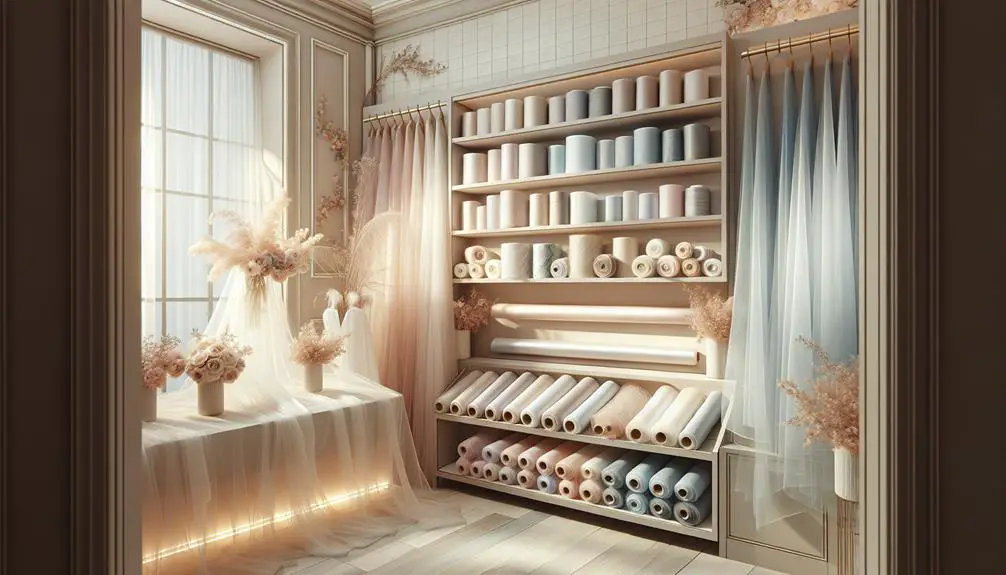I've noticed organza's popularity stems from its unique blend of beauty and practicality. Its sheer, lightweight nature paired with a crisp texture allows it to create dramatic, enduring silhouettes without feeling heavy. This fabric's versatility shines in both fashion and home decor; it's perfect for layering and adds a touch of elegance without overpowering other elements. Plus, its sturdy yet delicate form supports intricate designs and embellishments. Organza's ability to blend trendiness with timeless appeal really sets it apart. If you're curious about how this fabric plays a role in sustainability and contemporary design, there's plenty more to uncover.
Table of Contents
Key Takeaways
- Organza's sheer, lightweight nature allows for elegant, translucent designs in fashion and decor.
- It offers a crisp texture and stiffness, ideal for creating dramatic silhouettes and volume without bulk.
- The fabric is versatile, used in everything from bridal wear to event decorations, enhancing its popularity.
- Organza supports intricate embellishments and embroidery, making it a favored choice for detailed, luxurious garments.
- Its durability and ease of care contribute to its widespread use and enduring appeal in various industries.
Timeless Aesthetic Appeal
Organza's sheer, lightweight nature has always given it a timeless aesthetic appeal. I can't help but marvel at its delicate yet structured form. It's this unique combination that makes organza not just a fabric, but an experience. When I first came across organza in a vintage shop, the way it played with light and shadow captivated me. It wasn't just fabric; it was almost ethereal.
The crisp texture, despite its soft appearance, is something you have to touch to believe. It's like a paradox in your hands. I've found that its stiffness allows for dramatic silhouettes that other fabrics can't hold a candle to. Yet, it's not just about looks; the feel of organza is equally important. Running your fingers across a piece of high-quality organza, you'll notice a smoothness that's quite different from more common textiles.
The beauty of organza also lies in its durability. Despite its delicate appearance, it's surprisingly tough. I've used the same organza table runner for years, and it still looks as pristine as the day I bought it. It's a testament to the fabric's enduring charm and practicality.
Versatility in Use
While I've admired organza's enduring appeal, I've also discovered its remarkable versatility in various applications. This fabric isn't just for bridal wear; it's everywhere. You can spot organza in fashion, from runway avant-garde pieces to ready-to-wear skirts that add a playful flair. But its use stretches far beyond clothing.
In home decor, organza works wonders. It's used for sheer curtain panels that filter light beautifully while offering a hint of privacy. This same translucency makes it perfect for lampshades, softening light to create a warm ambiance in any room. I've even seen it used creatively in art installations, where its ability to hold shape and diffuse light dynamically plays a crucial role.
Moreover, the fabric's lightness makes it ideal for layering in both apparel and decor, enabling designers to play with depth and dimension without the bulk. It's this unique blend of lightness and strength that also makes organza a favorite for event decorations, like draping material for weddings or festive occasions, providing an ethereal feel to any setting.
Unique Textural Qualities
I've always been fascinated by organza's unique textural qualities that set it apart from other fabrics. Its sheer, lightweight nature paired with a slightly stiff feel due to its tight weave is something truly special. This combination not only gives it a crisp drape but also creates a subtle, yet captivating, luster that plays beautifully with light. The fabric's body and form, which can seem almost sculptural, are perfect for creating voluminous designs without the bulk.
What's more, organza's texture allows it to hold embroidered designs and embellishments exceptionally well. Unlike heavier fabrics that might sag or warp under the weight of adornments, organza supports them with grace. This makes it ideal for detailed, intricate patterns that require a delicate yet strong backing. The stiffness primarily comes from the silk, polyester, or nylon fibers it's woven from, each contributing to its durability and unique feel.
Handling organza, I appreciate its crispness and the way it moves. Despite its delicate appearance, it's surprisingly resilient and offers a tactile experience like no other fabric. It's this distinct blend of properties that not only captures the imagination but also challenges designers to explore its versatility in texture and form.
Fashion and Functionality
Beyond its unique texture, organza also offers remarkable functionality in the world of fashion. It's this practical versatility that makes it a go-to for designers and fashion enthusiasts alike. Let's break down what makes organza so exceptionally useful:
- Sheer Brilliance:
Organza's sheer nature allows for layering without adding bulk, making it perfect for creating volume and a dreamy silhouette. It's all about adding that ethereal touch without weighing down the outfit. You can see this in everything from bridal wear to avant-garde runway pieces.
- Structural Flexibility:
Despite its delicate appearance, organza holds its shape incredibly well. This is crucial when crafting garments that need to stand out and maintain form, like puffed sleeves or structured dresses. It's a magical fabric that combines lightness with a stiff demeanor, which is pretty rare!
- Durability and Ease of Care:
Organza is surprisingly durable for such a lightweight material. It resists wrinkles and retains its color well. Plus, it's easier to care for than other luxury fabrics, making it not just beautiful but also practical for regular use.
In a nutshell, organza isn't just about looks; it's about making fashion both functional and fabulous.
Trends in Organza Use
Organza's making waves in the fashion industry, notably in how it's being innovatively used by contemporary designers. It's not just about those flouncy dresses anymore. Now, I'm seeing organza in everything from sharp, structured suits to edgy, layered streetwear. The sheer, lightweight fabric is being manipulated in ways that really push the envelope on texture and form.
One of the hottest trends is the use of organza for creating volume without the bulk. Designers are cleverly inserting it into sleeves and skirts, giving outfits a dramatic, ethereal puffiness that's both eye-catching and surprisingly wearable. It's a perfect blend of fairy-tale and avant-garde, and honestly, it's hard not to fall in love with the effect.
Then there's the color play. With organza, you can layer colors subtly, creating a rich, multi-dimensional look that changes with the light. This technique is popping up all over runways, turning simple designs into optical illusions. As a fabric that dances between transparency and bold color, organza offers designers a unique palette to work with.
Moreover, the sustainability angle is gaining traction. More designers are sourcing recycled organza, tapping into a market that's both style-conscious and environmentally aware. It's a win-win, really.
Frequently Asked Questions
How Do You Properly Clean and Maintain Organza Garments?
I always hand wash my organza garments in cold water with mild detergent. I avoid wringing them out and dry them flat. Ironing should be on a low setting with a pressing cloth.
Is Organza Fabric Environmentally Friendly?
I've learned that organza's environmental impact depends on its material. Silk organza is more eco-friendly than synthetic versions, which often involve harmful chemicals and non-renewable resources during production.
Can Organza Cause Allergic Reactions to Sensitive Skin?
I've heard that organza can irritate sensitive skin due to its stiff, synthetic fibers. If you're prone to allergies, it might be best to choose softer, natural fabrics to avoid any reactions.
What Is the Historical Origin of Organza Fabric?
Organza fabric originated in the Middle Ages in Turkestan but became popular in Europe, specifically in France and Italy, during the Renaissance. It's traditionally made from silk, giving it a luxurious lightweight feel.
How Does Organza React to Different Weather Conditions?
Organza's like a moody artist when it comes to weather: it shines in dry, cool conditions but can throw a fit in humidity, losing its crisp texture and becoming limp and less manageable.
- Why Is Organza so Popular? - April 23, 2024
- What Do You Wear With Organza? - April 23, 2024
- Which Is Better Organza or Chiffon? - April 23, 2024






